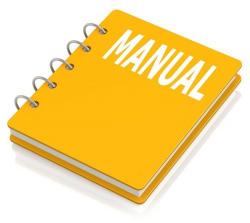Hyundai Construction Crawler Excavator HX220L, HX220NL Factory Service & Shop Manual
Catalog:
Model:
Complete workshop & service manual with electrical wiring diagrams for Hyundai Construction Crawler Excavator HX220L, HX220NL. It's the same service manual used by dealers that guaranteed to be fully functional and intact without any missing page.
This Hyundai Construction Crawler Excavator HX220L, HX220NL service & repair manual (including maintenance, overhaul, disassembling & assembling, adjustment, tune-up, operation, inspecting, diagnostic & troubleshooting…) is divided into different sections. Each section covers a specific component or system with detailed illustrations. A table of contents is placed at the beginning of each section. Pages are easily found by category, and each page is expandable for great detail. The printer-ready PDF documents work like a charm on all kinds of devices.
EXCERPT:
CONTENTS
SECTION 1 GENERAL
Group 1 Safety Hints - - - - - 1-1
Group 2 Specifications - - - - - 1-10
SECTION 2 STRUCTURE AND FUNCTION
Group 1 Pump Device - - - - - - 2-1
Group 2 Main Control Valve - - - - - - 2-20
Group 3 Swing Device - - - - - - 2-47
Group 4 Travel Device - - - - 2-58
Group 5 RCV Lever - - - - 2-72
Group 6 RCV Pedal - - - - 2-79
SECTION 3 HYDRAULIC SYSTEM
Group 1 Hydraulic Circuit - - - - 3-1
Group 2 Main Circuit - - - - - - 3-2
Group 3 Pilot Circuit - - - - 3-5
Group 4 Single Operation - - - - 3-14
Group 5 Combined Operation - - - - - 3-24
SECTION 4 ELECTRICAL SYSTEM
Group 1 Component Location - - - - - 4-1
Group 2 Electrical Circuit - - - - 4-3
Group 3 Electrical Component Specification - - - - - 4-21
Group 4 Connectors - - - - - - 4-29
SECTION 5 MECHATRONICS SYSTEM
Group 1 Outline - - - - - 5-1
Group 2 Mode selection System - - - - 5-3
Group 3 Automatic Deceleration System - - - - - 5-6
Group 4 Power Boost System - - - - - 5-7
Group 5 Travel Speed Control System - - - - - - 5-8
Group 6 Automatic Warming Up Function - - - - 5-9
Group 7 Engine Overheat Prevention Function - - - - 5-10
Group 8 Variable Power Control System - - - - - - 5-11
Group 9 Attachment Flow Control System - - - - - - 5-12
Group 10 Boom Floating Control System - - - - 5-13
Group 11 Intelligent Power Control System - - - - 5-14
Group 12 Anti-Restart System - - - - 5-16
Group 13 Self-Diagnostic System - - - - - 5-17
Group 14 Engine Control System - - - - - 5-54
Group 15 EPPR (Electro Proportional Pressure Reducing) Valve - - - - - - 5-55
Group 16 Monitoring System - - - - - - 5-60
Group 17 Fuel Warmer System - - - - - 5-95
SECTION 6 TROUBLESHOOTING
Group 1 Before Troubleshooting - - - - - 6-1
Group 2 Hydraulic and Mechanical System - - - - 6-4
Group 3 Electrical System - - - - - - 6-24
Group 4 Mechatronics System - - - - 6-40
SECTION 7 MAINTENANCE STANDARD
Group 1 Operational Performance Test - - - - - - 7-1
Group 2 Major Components - - - - - - 7-21
Group 3 Track and Work Equipment - - - - - 7-29
SECTION 8 DISASSEMBLY AND ASSEMBLY
Group 1 Precaution - - - - - 8-1
Group 2 Tightening Torque - - - - - 8-4
Group 3 Pump Device - - - - - - 8-7
Group 4 Main Control Valve - - - - - - 8-30
Group 5 Swing Device - - - - - - 8-54
Group 6 Travel Device - - - - 8-84
Group 7 RCV Lever - - - - - 8-116
Group 8 Turning Joint - - - - - 8-130
Group 9 Boom, Arm and Bucket Cylinder - - - - - 8-135
Group 10 Undercarriage - - - - - 8-152
Group 11 Work Equipment - - - - 8-164
SECTION 9 COMPONENT MOUNTING TORQUE
Group 1 Introduction guide - - - - - 9-1
Group 2 Engine system - - - - 9-2
Group 3 Electric system - - - - 9-4
Group 4 Hydraulic system - - - - - - 9-6
Group 5 Undercarriage - - - - - 9-10
Group 6 Structure - - - - - 9-11
Group 7 Work equipment - - - - - 9-15
…
GROUP 8 TURNING JOINT
1. REMOVAL AND INSTALL
REMOVAL
Lower the work equipment to the ground and stop the engine.
Operate the control levers and pedals several times to release the remaining pressure in the hydraulic piping.
Loosen the breather slowly to release the pressure inside the hydraulic tank.
Escaping fluid under pressure can penetrate the skin causing serious injury.
When pipes and hoses are disconnected, the oil inside the piping will flow out, so catch it in oil pan.
Disconnect all hoses.
Sling the turning joint assembly (1) and remove the mounting bolt (2).
·Weight : 55 kg (120 lb)
·Tightening torque : 12.3±1.3 kgf·m
(88.9± 9.4 lbf·ft)
Remove the turning joint assembly.
When removing the turning joint, check that all the hoses have been disconnected.
INSTALL
Carry out installation in the reverse order to removal.
Take care of turning joint direction.
Assemble hoses to their original positions.
Confirm the hydraulic oil level and check the hydraulic oil leak or not.
…





